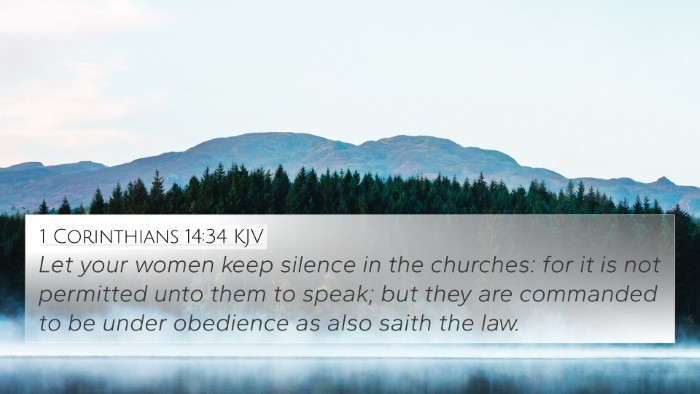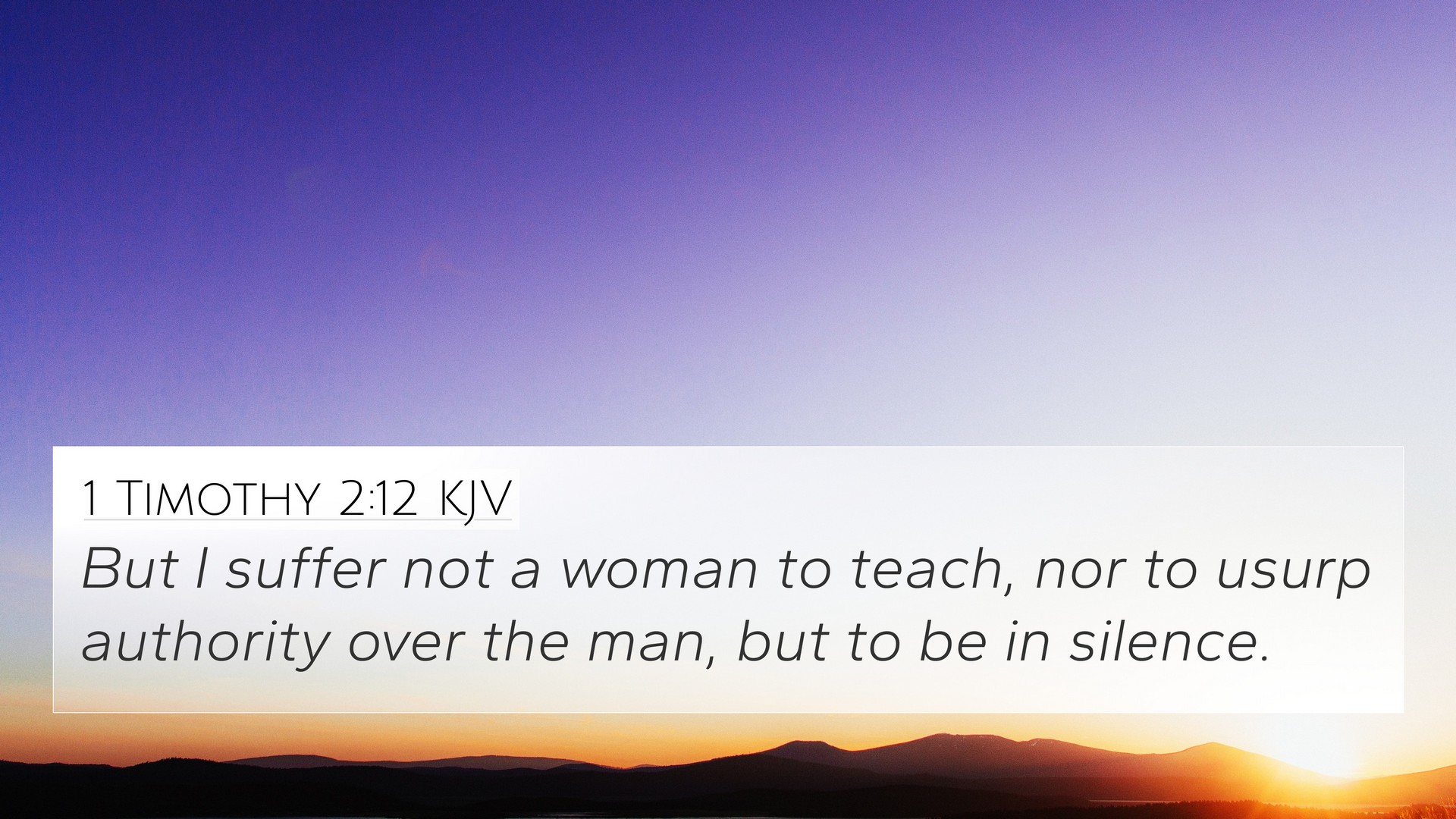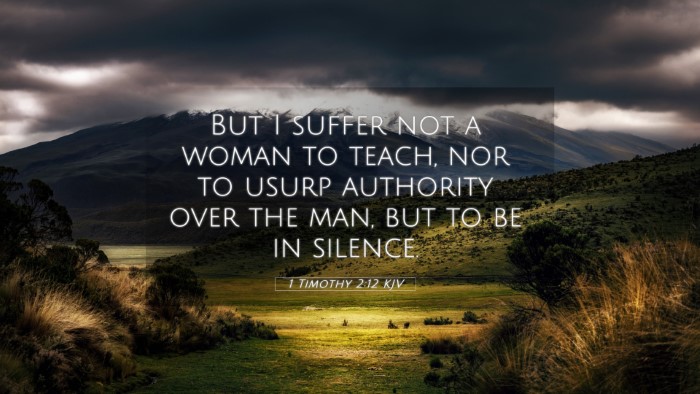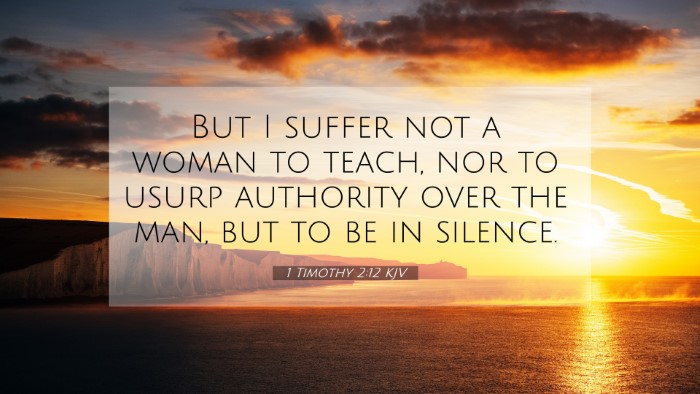Old Testament
Genesis Exodus Leviticus Numbers Deuteronomy Joshua Judges Ruth 1 Samuel 2 Samuel 1 Kings 2 Kings 1 Chronicles 2 Chronicles Ezra Nehemiah Esther Job Psalms Proverbs Ecclesiastes Song of Solomon Isaiah Jeremiah Lamentations Ezekiel Daniel Hosea Joel Amos Obadiah Jonah Micah Nahum Habakkuk Zephaniah Haggai Zechariah Malachi1 Timothy 2:12 Similar Verses
1 Timothy 2:12 Cross References
But I suffer not a woman to teach, nor to usurp authority over the man, but to be in silence.
Uncover the Rich Themes and Topics of This Bible Verse
Listed below are the Bible themes associated with 1 Timothy 2:12. We invite you to explore each theme to gain deeper insights into the Scriptures.
1 Timothy 2:12 Cross Reference Verses
This section features a detailed cross-reference designed to enrich your understanding of the Scriptures. Below, you will find carefully selected verses that echo the themes and teachings related to 1 Timothy 2:12 KJV. Click on any image to explore detailed analyses of related Bible verses and uncover deeper theological insights.

1 Corinthians 14:34 (KJV) »
Let your women keep silence in the churches: for it is not permitted unto them to speak; but they are commanded to be under obedience as also saith the law.
1 Timothy 2:12 Verse Analysis and Similar Verses
Understanding 1 Timothy 2:12
The verse 1 Timothy 2:12 states, "But I suffer not a woman to teach, nor to usurp authority over the man, but to be in silence." This verse has been the subject of much analysis and interpretation within Christian communities. Combining insights from various public domain commentaries provides a broader understanding of its meaning and implications.
Contextual Background
In examining this verse, one must consider its placement within the larger context of Paul's letter to Timothy. Paul was addressing issues in the early Church, including the conduct of individuals during worship and the role of women in ministry.
Insights from Matthew Henry
Matthew Henry's commentary emphasizes that Paul's instruction was not an absolute prohibition of women's teaching roles, but rather aimed at maintaining order and authority within the worship setting. He argues that the directive reflects the cultural context of the time, where women were not typically educated and could create confusion in doctrinal matters.
Insights from Albert Barnes
Albert Barnes interprets this verse as a guideline for church order. He highlights that the prohibition against women teaching or usurping authority likely stems from the order of creation as reflected in Genesis. Barnes also suggests that women should fulfill their roles in a manner consistent with God’s design, which includes a posture of submission during worship.
Insights from Adam Clarke
Adam Clarke discusses the implications of this verse within the lens of contemporaneous practices of the early Church. He points out that the local context in Ephesus, where Timothy was serving, included false teachings proliferated by certain women. Clarke emphasizes the importance of sound teaching over cultural practices, arguing that the core issue was the need for biblical authority in the church, rather than merely the roles of men and women.
Key Themes and Interpretations
- Authority and Order: The verse outlines the necessity for order in the church, indicating that roles should be clearly defined.
- Cultural Context: The cultural norms of the time are crucial for interpreting the application of this verse today.
- Role of Women: While the verse appears restrictive, it can lead to discussions about the evolving role of women in ministry and leadership.
Bible Cross-References
This verse can be understood more clearly in light of several cross-referenced scriptures:
- Genesis 2:18: Discusses the creation of woman and the relationship with man.
- 1 Corinthians 14:34-35: Shares similar thoughts on the role of women in church gatherings.
- Ephesians 5:22-24: Addresses the submission of wives to their husbands as part of marital order.
- Titus 2:3-5: Encourages older women to teach younger women, highlighting instructive roles.
- 1 Peter 3:1: Discusses the conduct of wives in relation to their husbands.
- Galatians 3:28: Emphasizes equality in Christ, allowing for a nuanced conversation about roles.
- Acts 2:17-18: Prophecies regarding the active role of women in ministry during the Spirit-filled church.
Conclusion
The interpretation of 1 Timothy 2:12 requires a careful balance between adherence to the scripture and an understanding of the cultural context in which it was written. The combined insights from Matthew Henry, Albert Barnes, and Adam Clarke provide a richer understanding of authority, teaching, and the role of women in the early church and the modern world. This verse invites continual study and reflection, particularly in how it connects to much broader themes in Scripture such as the use of spiritual gifts and the nature of church leadership.
Exploring Cross-Referencing
For readers seeking to delve deeper, the use of cross-references serves as a valuable tool in uncovering connections between biblical texts that enhance understanding. Engaging in comparative Bible verse analysis illuminates complex themes while illustrating the coherence and unity of Scripture.


